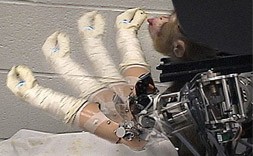02/18/2005:  Technologica
Technologica
Monkey Brains Control Robot Arm
nicked from Gizmodo Your fantasy of getting a handjob from Lee Majors is one step closer to reality, thanks to this new robot arm controlled by thought alone. Scientists at University of Pittsburgh have successfully tested the arm and hand unit with monkeys and ready to explore the the potential for fully functional prosthetic arms. And before the nightmares of armies of patchwork cyborg monkeys turning on their creators kick in, don't worry: the monkeys were allowed to keep their arms. Doctors humanely strapped them down and inserted small probes into the motor functions of their brains, killing them instantly.
Your fantasy of getting a handjob from Lee Majors is one step closer to reality, thanks to this new robot arm controlled by thought alone. Scientists at University of Pittsburgh have successfully tested the arm and hand unit with monkeys and ready to explore the the potential for fully functional prosthetic arms. And before the nightmares of armies of patchwork cyborg monkeys turning on their creators kick in, don't worry: the monkeys were allowed to keep their arms. Doctors humanely strapped them down and inserted small probes into the motor functions of their brains, killing them instantly.
For the BBC article that the above refers to, check out "more" below.
More
Brain-controlled 'robo-arm' hopeBy Michelle Roberts
BBC News health reporter, in Washington DC
Scientists in the US have created a robotic arm that can be controlled by thought alone.
Developed at Pittsburgh University, it has a fully mobile shoulder and elbow and a gripper that works like a hand.
In early tests, monkeys had tiny probes inserted into their brains and had their limbs restrained - but were then able to manipulate the robotic arm.
The inventors believe it could help people who have lost limb function through disease or trauma.
The mechanical arm research was described at the annual meeting of the American Association for the Advancement of Science held this year in Washington DC.
Averaged message
Human tests have already shown corresponding patterns of brain signals linked to limb movements.
Dr Andrew Schwartz's team inserted a number of tiny probes into the brains of monkeys.
The probes interpret signals from individual nerve cells in the motor cortex.
Given that even the smallest of movements involve thousands of nerve signals too numerous to track, the scientists used a gadget to work out the most important signals.
The computer algorithm averages out the dominant signals to obtain the overall movement picture, which they called the "population vector".
Human trials
The algorithm then sends this dominant movement message to the robotic arm, which carries out the actions the monkey intended to perform with its own limbs.
The monkeys in the experiment were able to grasp and hold food with the robotic arm while their real arms were restrained.
"We can use the population vector to accurately predict the velocity and direction of normal arm movement," said Dr Schwartz.
"It moves much like your own arm would move," he added.
Dr Schwartz said his team was working to develop a prosthesis with realistic hand and finger movements.
But he explained it would be a much bigger challenge to recreate more complex movements, such as those of the human hand.
"Our biggest problem is durability of the probes. Typically they last for about six months."
With time, tissue growth over the probes could interfere with their transmission, he said.
Schwartz' team hopes to overcome this problem and begin testing in humans within the next four years.


